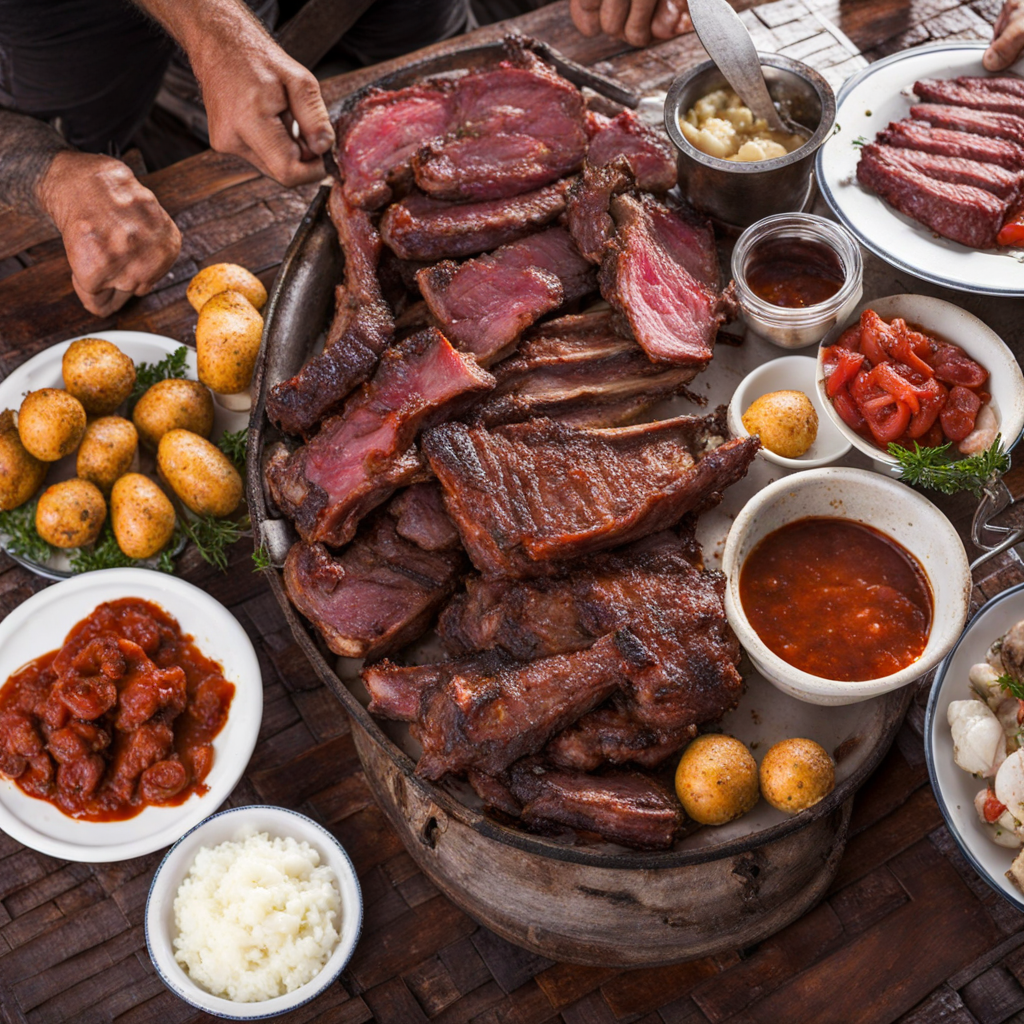Arroz con Leche
Arroz con Leche is a traditional Uruguayan dessert that beautifully combines the simplicity of rice with the creamy richness of milk, resulting in a comforting dish that warms the soul. The basic ingredients typically include short-grain rice, whole milk, sugar, and a hint of salt. The rice is slowly cooked in milk, allowing it to absorb the creamy goodness, while the sugar sweetens the mixture to perfection. This slow cooking process creates a delightful texture, where the rice becomes tender and slightly sticky, enveloped in a smooth, velvety sauce. To enhance the flavor profile, a variety of aromatic spices can be added to the pot. Cinnamon is a classic choice, often infused in the cooking liquid, providing a warm and inviting fragrance that fills the kitchen. Some recipes may also call for lemon or orange zest, lending a zesty brightness that cuts through the richness. Once the dish is cooked, it is typically served warm or chilled, often garnished with a sprinkle of cinnamon or a drizzle of caramel sauce for added indulgence. Arroz con Leche is more than just a dessert; it is a cherished part of Uruguayan culture, often enjoyed during family gatherings and festive occasions. It evokes feelings of nostalgia and comfort, reminding many of their childhood. The dish is highly versatile, allowing for variations that incorporate different flavors and toppings, making it a delightful canvas for creativity. Whether you savor it as a quick snack or as a special treat after dinner, Arroz con Leche promises a unique and satisfying taste experience that captures the essence of Uruguayan cuisine.
How It Became This Dish
The Story of Arroz con Leche: A Comforting Dish from Uruguay #### Origins Arroz con leche, or rice with milk, is a beloved dish throughout Latin America, with each country adding its unique twist to this comforting classic. In Uruguay, it stands out not only as a staple dessert but also as a symbol of cultural heritage and familial traditions. The origins of arroz con leche can be traced back to the Spanish colonial era, where rice, milk, and sugar were combined, creating a dish that was both economical and satisfying. The introduction of rice to the Americas can be attributed to the Spanish and Portuguese, who brought it from Asia during their explorations and colonization efforts. As the dish traveled across the Spanish colonies, it evolved into various regional adaptations. The basic ingredients of rice, milk, and sugar remained constant, but local flavors and practices influenced its preparation. In Uruguay, arroz con leche became a cherished dessert, often prepared for family gatherings, special occasions, or simply as a comforting treat on a rainy day. #### Cultural Significance In Uruguay, arroz con leche transcends its role as a mere dessert; it embodies nostalgia and familial love. Many Uruguayans have fond memories of their grandmothers stirring large pots of this creamy delight on the stove, the sweet aroma wafting through the house, inviting family members to gather around the kitchen. It is a dish associated with warmth, comfort, and the simple pleasures of life. Culturally, arroz con leche is often prepared during significant celebrations, such as Christmas and family gatherings, where it serves as a symbol of abundance and sharing. The dish can also be found at various food festivals, showcasing its importance not only in home kitchens but also within the broader culinary landscape of Uruguay. In this way, arroz con leche serves as a culinary bridge connecting generations, allowing families to pass down recipes and stories, ensuring that the traditions surrounding this dish continue to thrive. #### Development Over Time As time progressed, arroz con leche in Uruguay underwent several transformations, influenced by both global culinary trends and local ingredients. Traditional recipes typically called for short-grain rice, which absorbs the milk's creaminess and softens during cooking. The preparation process involves simmering the rice in milk with sugar until it reaches a thick, pudding-like consistency. Common flavorings include vanilla, cinnamon, and lemon zest, which add depth and richness to the dish. In the late 20th century and early 21st century, as Uruguayan cuisine began to embrace a more diverse array of influences, arroz con leche started to reflect contemporary tastes and preferences. Chefs began experimenting with alternative sweeteners, such as honey or agave syrup, catering to health-conscious consumers. The incorporation of coconut milk became popular, creating a tropical twist on the traditional recipe. This adaptation not only appealed to modern palates but also demonstrated the flexibility of the dish in accommodating various dietary needs. Furthermore, the rise of artisanal dessert shops and modern culinary techniques brought new life to arroz con leche. Creative presentations, such as serving it in elegant glass jars or pairing it with fresh fruits and nuts, elevated the dish's status from a humble home-cooked meal to a gourmet dessert. This evolution reflects a broader trend in Uruguayan cuisine, where traditional dishes are reinterpreted and presented in innovative ways, all while maintaining their cultural essence. #### Contemporary Variations and Global Influence In recent years, the global food scene has continued to embrace arroz con leche, leading to its incorporation into international menus and culinary festivals. In Uruguay, international influences have encouraged chefs to explore fusion variations, blending traditional arroz con leche with ingredients from other cultures. For example, some versions incorporate matcha powder or spices like cardamom, reflecting the growing trend of incorporating diverse flavors into classic dishes. Social media has played a significant role in this evolution, allowing home cooks and professional chefs alike to share their unique takes on arroz con leche. Instagram and other platforms have led to a resurgence in interest, with visually striking presentations attracting attention and inspiring new generations to experiment with the dish. #### Conclusion Arroz con leche in Uruguay is more than just a dessert; it is a cherished emblem of culture, family, and tradition. Its journey from a humble colonial dish to a beloved staple of Uruguayan cuisine reflects the rich tapestry of influences that have shaped the country's culinary landscape. As it continues to evolve, adapting to modern tastes while preserving its heart and soul, arroz con leche remains a reminder of the power of food to connect people, evoke memories, and celebrate heritage. In a world that is constantly changing, arroz con leche stands as a testament to the enduring nature of culinary traditions. Whether enjoyed at a family gathering, a festive celebration, or as a comforting dessert after a long day, this dish will forever hold a special place in the hearts of Uruguayans and food lovers around the globe. The simple combination of rice, milk, and sugar has woven itself into the cultural fabric of Uruguay, binding generations together through the love of food and the joy of sharing.
You may like
Discover local flavors from Uruguay







